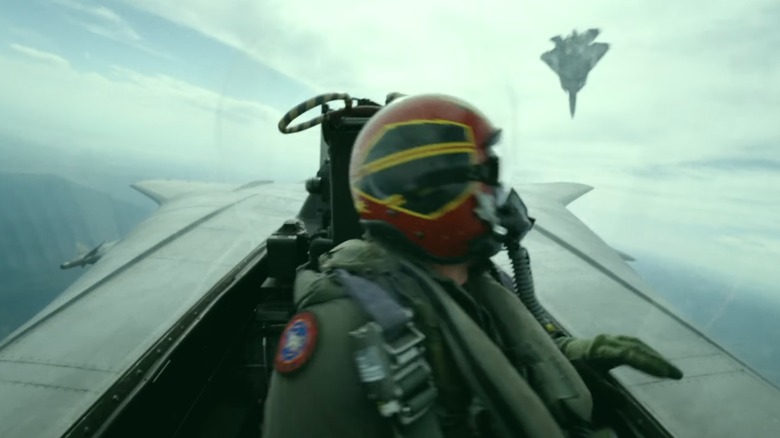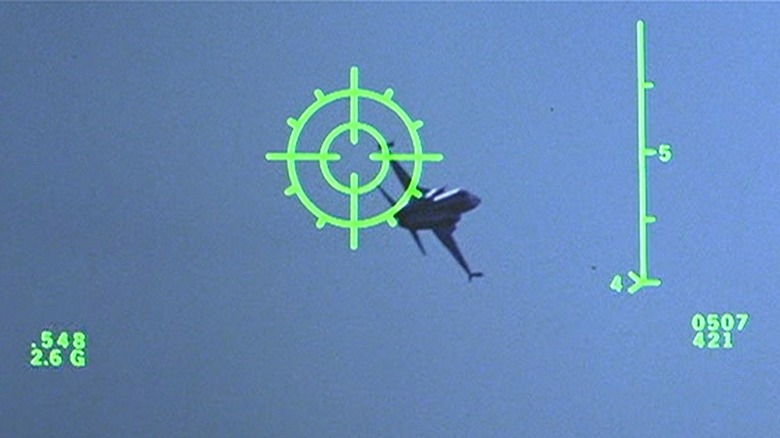How Do Fighter Pilots Know When They're Being Painted By Radar And When The Enemy Has Locked On?
You've probably seen it in movies like "Iron Eagle," "Top Gun," and "Hot Shots," – a pilot is flying through the sky when they're suddenly alerted that they're being "painted" by radar. This happens whenever an enemy missile locks onto a target, giving the pilot who has been fired upon enough notice to evade the attack with flares or chaff. While there's a lot of technical information on the science involved, it can be boiled down to some core elements that are easy to understand.
For the most part, whenever an enemy locks onto a hero in a movie, they're doing so via their plane's onboard radar system. It operates in either search or track modes, the former being used to identify specific targets, while the latter functions more broadly. When a radar signal is reflected back to the aircraft that sent it, the pilot is alerted to an adversary.
A lot of this depends on the type of air-to-air missiles (AAM) being fired, because heat-seeking missiles don't require a radar lock. The pilot only needs to line up a shot and get a "good tone" to hit the target. As far as a targeted aircraft being alerted to being painted, that's to do with radar as well. Radar functions by sending and receiving powerful signals, and an onboard Radar Warning Receiver, like those found on electronic warfare aircraft, works to identify the source of a signal by displaying the azimuth. Additional information can be gleaned about the signal type and origin.
How fighter jets fire missiles at targets
Whether they flew something like the retired F-111 Aardvark or the far more advanced and incredibly fast F-35 Lightning II, firing missiles at targets requires several components. If a pilot fires a missile, they're going to give a verbal acknowledgement over the radio, saying "Fox One," "Fox Two," or "Fox Three." You've likely heard this in a movie once or twice, and it's not nonsense. Fox One refers to semi-active radar-guided missiles, Fox Two deals with infrared-guided (heat-seeking) missiles, and Fox Three refers to active radar-guided missiles.
As previously mentioned, infrared-seeking missiles, like the AIM-9 Sidewinder, don't require the pilot to establish a lock to fire or hit their targets. That's not true of semi-active radar-guided missiles, which use a passive onboard radar that's augmented by an external radar source from the plane that fires it. Examples include the AIM-4 Falcon, which was the first operational guided AAM. Active radar-guided missiles are more complex due to their active radar transceivers that require more power and equipment to operate.
The benefit of firing a Fox Three missile like the AIM-120 AMRAAM is that guidance is significantly improved at greater distances, as they are difficult to thwart with electronic countermeasures. Once they enter the terminal phase, the firing plane no longer requires a radar lock, making Fox Three ordnance more like a fire-and-forget weapon that requires far less attention from the pilot once it's fired.
What happens to the targeted aircraft
A fighter pilot is minding their own business, zooming past the airspace of a hostile nation, when something unforeseen happens: a missile has locked onto them. This occurs when the plane's onboard Radar Warning Receiver (RWR) detects a signal that its onboard computer system analyzes and determines to be a threat. It can potentially understand the type of radar being used, and that can inform the pilot as to the type of aircraft on their tail.
Modern RWRs can isolate multiple signals and determine which represents a greater threat, which is accomplished via specific icons and shapes displayed on the Heads-Up Display (HUD). With this information provided to the pilot almost instantaneously, they can take action to ensure their survival. A Laser Warning System alerts the pilot if their plane is being targeted via laser range-finder, as many ground-based surface-to-air missile launchers use this technology alongside targeting pods, so multiple systems are onboard to help in protecting the aircraft.
RWR isn't limited to displaying information on the screen. It also incorporates an audio component. Different tones can alert the pilot to the type of threat they face, and they're trained to identify multiple sounds. A continuous sound means a radar is locked onto the aircraft in track mode. Other tones inform the pilot to a missile's mode. Whenever one goes off, it cues the pilot to take action and avoid the threat. All of these defensive systems come together to ensure aircraft and pilot survivability in as many situations as possible.


